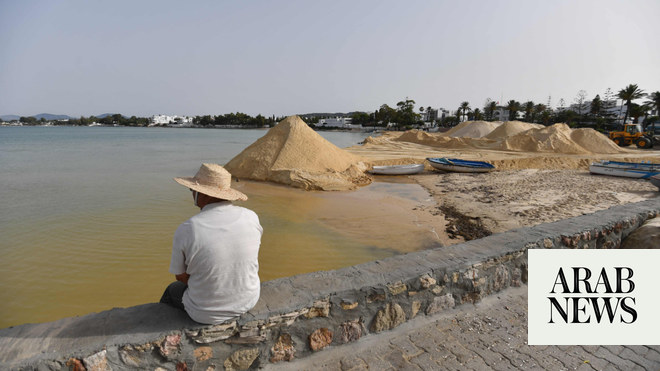HAMAMET, TUNISIA: In the Tunisian seaside city of Hammamet, excavators are hard at work digging sand from the nearby desert onto a popular beach in an effort to prevent it from being lost to erosion.
“This beach is like a postcard of Hammamet,” environmentalist Chiheb Ben Fredj said as he looked nostalgically at the city’s iconic Yasmine Beach.
“This has been ingrained in us since we were kids,” he added, as workers worked to restore Tunisia’s central coastline to its former glory.
Like many other coastal areas in North Africa, severe erosion has taken away parts of Hammamet's sandy beaches in recent years, affecting the popular tourist destination about 65 kilometres (40 miles) east of the capital Tunis.
Coastlines around the world are constantly changing naturally, with the sea overlying and depositing sediments.
However, human activities, including coastal development and offshore sand mining, are significantly accelerating beach erosion.
The impacts of construction and coastal protection in an area may prevent sediment from moving along the coast, leaving existing beaches devoid of fresh material.
Studies have shown that the effects of climate change, such as rising temperatures and sea levels, are making the phenomenon worse.
In the Mediterranean, where the UK National Oceanographic Centre says sea levels have risen at a faster rate in the past 20 years than in the whole of the 20th century, coastlines are changing rapidly.
Oceans are warming 20 percent faster than the rest of the world, according to the United Nations.
Tunisia's coastline is a key asset for the struggling Mediterranean nation, which aims to welcome around 10 million tourists this year.
Tourism accounts for 14 percent of the country's GDP, creating tens of thousands of jobs in a country with an unemployment rate as high as 16 percent, and 40 percent of those jobs are among young people.
Tunisia has lost more than 90 kilometers of beach to erosion, according to official figures from last year.
Of the country's 570 kilometers of sandy beaches suitable for swimming, 190 kilometers are at risk of disappearing soon, Tunisia has reported.
Most of the beaches most affected by erosion are located near cities.
Tunisian environmental groups, including the government's Coastal Protection and Development Authority (APAL), blame the rapid erosion largely on human activities and coastal construction, which they say are also making climate change worse.
“The construction project was not designed to respect the dynamics of the coast,” an APAL official told AFP.
To help Hammamet beach, one of Tunisia's worst hit beaches according to the World Bank, officials last month began bringing in about 750 trucks loaded with sand from the desert province of Cairo, some 110 kilometers away.
APAL, which operates under the Ministry of Environment, is expediting efforts to recharge beaches ahead of the peak tourist season.
While rebuilding the beach, known as beach nourishment, may be a quick fix, “it’s not a sustainable solution,” Ben Fredge said.
“This sand probably won’t last long,” added the secretary of the Environmental Education Association.
“In the event of a storm, it could be swallowed up in a matter of days,” he said, as was the case in the summer of 2023.
Such a process can also be expensive.
Coastal authorities estimate the cost of restoring sand on three beaches in Hammamet, Monastir and Sfax at 3.9 million Tunisian dinars ($1.25 million).
But for locals, restoring their precious beach is worth it.
“Yasmin Beach is Hammamet’s showcase,” said Narges Boesker, who runs the city’s Menara Hotel and heads the regional hotel federation.
“We must bring back the beaches that the sea has swallowed,” she said, calling for a balance between protecting a landscape beloved by both locals and international tourists, and combating coastal erosion.
“For us, the most important thing is not to touch the beauty of the city,” she said.
Bouasker said she sees officials becoming more aware, but adding sand to beaches remains a risk.
“We don’t know how the sea will respond,” she added.
